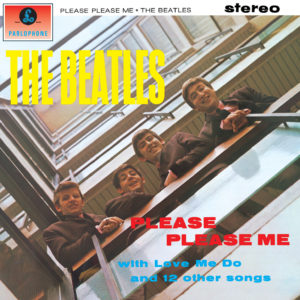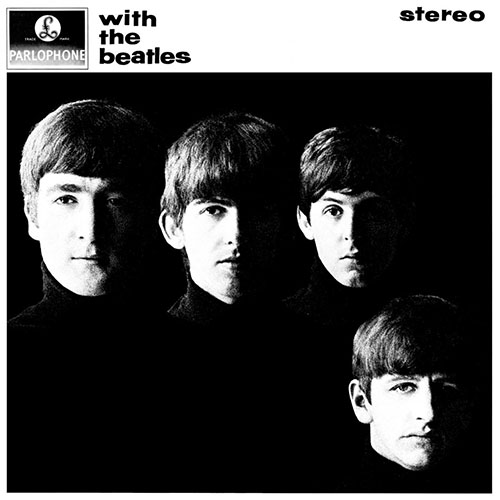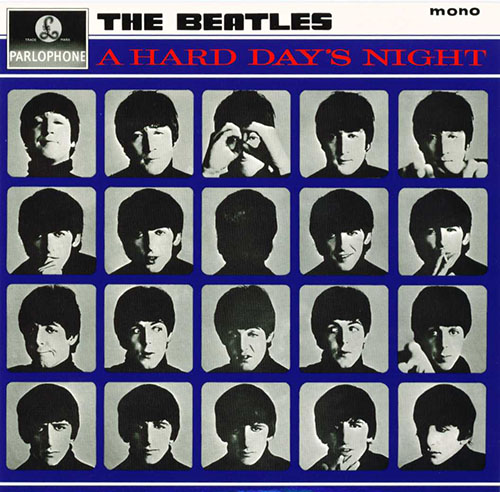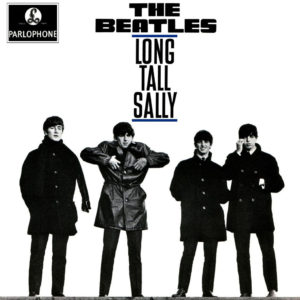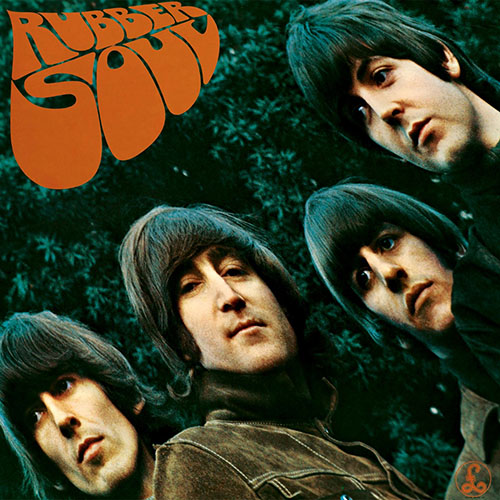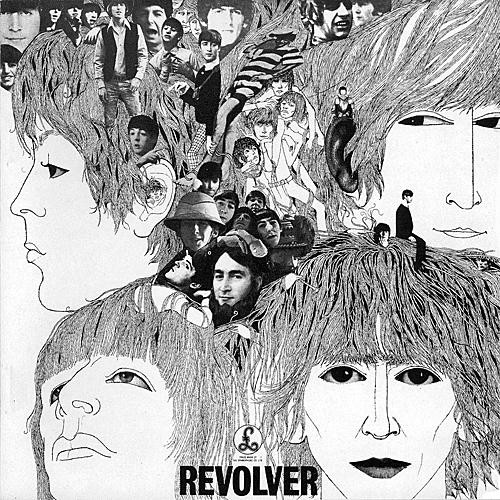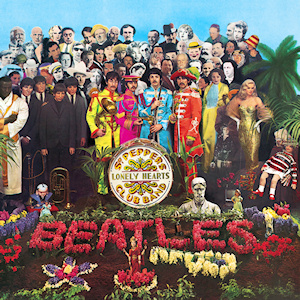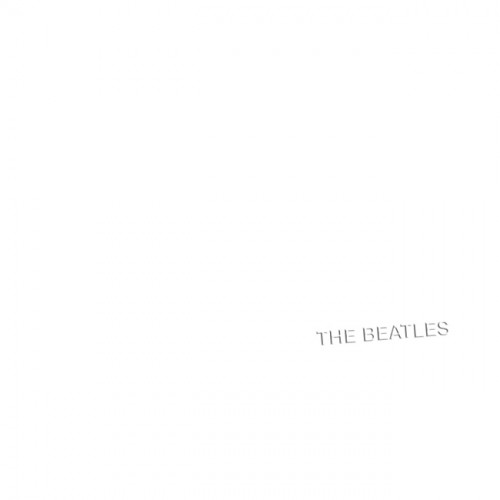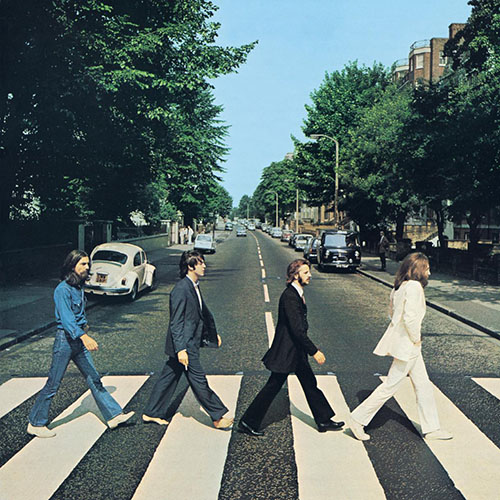
John Lennon
Born: October 9, 1940, Liverpool, England
Assassinated: December 8, 1980, New York City, New York
Member of the Silent Generation
Paul McCartney
Born: June 18, 1942, Liverpool, England
Member of the Silent Generation
George Harrison
Born: February 25, 1943, Liverpool, England
Died: November 29, 2001, Los Angeles, California
Member of the Boom Generation
Ringo Starr (nee: Richard Starkey)
Born: July 7, 1940, Liverpool, England
Member of the Silent Generation
Stuart Sutcliffe
Born: June 23, 1940. Edinburgh, Scotland
Died: April 10, 1962, Hamburg, West Germany
Member of the Silent Generation
Pete Best (nee: Randolph Peter Scanland)
Born: November 24, 1941, Madras, British India
Member of the Silent Generation
To say that The Beatles were the greatest act in the history of show business can only be an understatement. To express their true greatness would be a feat that would tax the English language to its fullest extent. Needless to say, the only reasonable approach to be taken by The Skinner Zone Rock and Roll Hall of Fame would be to create a separate category exclusively for them. This category includes The Beatles as a group, and each of its members as a solo artist.
The Beatles released so many albums and singles in various configurations for different countries around the world that nobody has been able to successfully catalog their entire output. Suffice it to say that they outdid even Elvis Presley and Frank Sinatra, and left just about every other lesser act, before and after, eating their dust.
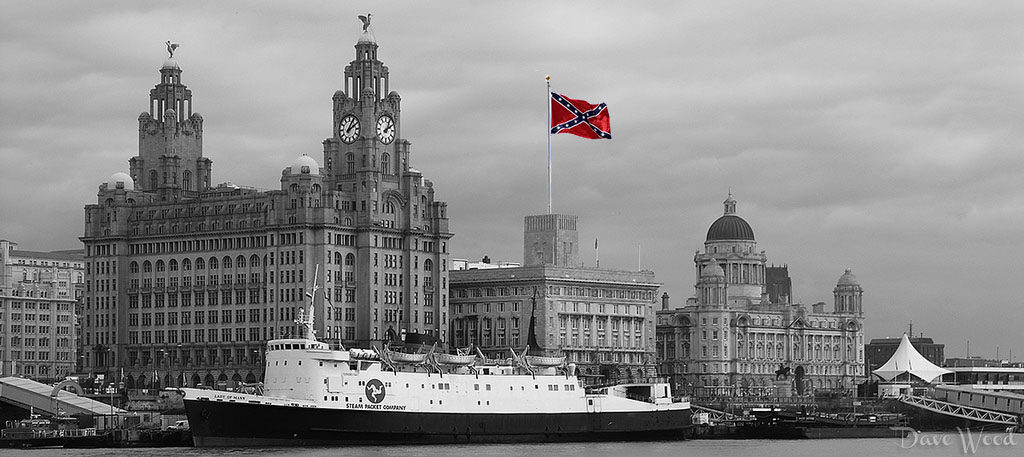
The greatness of their music notwithstanding, the story of The Beatles and their rise to fame and fortune is not a pretty one - in fact, it is quite bizarre. When they got their start in Liverpool, they came off as the biggest bunch of clowns in the history of show business. The fact that they came from Liverpool should be sufficient to indicate their true nature. Located on England's northwestern coast, this port city is so dreary that everything appears to be in black and white. Bright colors do not even wish to be seen in the vicinity; they will not voluntarily get any closer to it than Manchester. Liverpool is home to a lot of rather dubious characters, who give the city a well-deserved reputation as a rough-and-tumble place not fit for decent women, children, and small animals. It is also notorious for its enthusiastic support for the Confederacy during the American Civil War. Nineteenth-century Liverpudlians were so pro-Confederate that the city became the unofficial twelfth Confederate State (or fourteenth, depending upon who is doing the counting.)
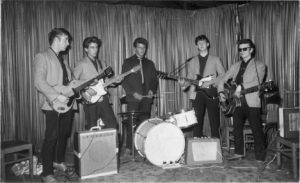
Before The Beatles showed up to inflict themselves upon the unsuspecting populace, Liverpool's biggest claim to musical fame is that it was the hometown of Lita Roza. She happened to be the first artist from there to have a number one hit record in England. In 1953, Patti Page had a huge hit in America with a song called "How Much Is That Doggy in the Window," which had just been written the year before. This song is a perfect illustration of the cultural wasteland that existed in the early 1950s, after the Big Band era faded away but before the advent of Rock and Roll. Lita Roza's manager persuaded her to record her own version of this song, which she did, and it became a huge hit over on the other side of the pond. This song is so pathetic that Roza herself even hated it, and refused to ever sing it again after she recorded it, right to her dying day.
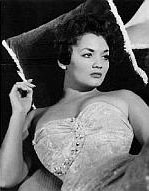
Inspired by the rise of Rock and Roll in America, many young men in Liverpool began to form their own beat groups, as they were called at the time. Most of them played a few local gigs, and then had enough decency and common courtesy to call it quits before inflicting themselves upon the rest of humanity. Not so with the Flab Four, as The Beatles would eventually become known. Becoming bored with creating havoc in their hometown after a number of months performing at the Craven, Liverpool's notorious underground music venue, they packed up all of their gear and headed for the Continent. They moved on to Hamburg, a notorious German seaport, which was reminiscent of Liverpool. If anything, the German city was even more depraved than was their hometown.
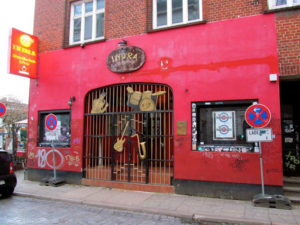
The Beatles initially began their Hamburg residency at a place called the Indra Club, which was located in the Reeperbahn, the most notorious part of town. The Reeperbahn was so bad and so dangerous that pimps, prostitutes, and drug dealers even refused to go there. This did not deter The Beatles, who took to their new environment with enthusiasm. Their nightly gigs at the Indra, and later at other nearby venues, went on all night. They were so uncouth in their performances that they not only ate their meals onstage, but continually lambasted their audiences with profanity-laced insults in English, which the German-speaking people did not understand. In addition, the noise emanating from the stage could not possibly be referred to as music. Not only did they all sing off-key, but each member of the band could be heard playing a completely different song at any given time.
Their audiences just ate it up. The louder and more profane they were, the more they loved it. There was no shortage of eager and willing babes at every gig, and The Beatles took full advantage whenever they were not performing. It has been rumored that they were treated so often for various venereal diseases that the entire Federal Republic of Germany completely ran out of antibiotics. In addition, it has been estimated that, after two or three generations, a good one-third of the German population born after 1960 contains some Beatle DNA.
In their blatant attempt to claw their way to the top, The Beatles left many bodies behind, and I happen to know where they are all buried. They claimed their first victim during their sojourn in Hamburg. At the time, there was a fifth Beatle, a fellow Liverpudlian by the name of Stuart Sutcliffe. Unlike John Lennon, Paul McCartney, George Harrison, and Pete Best, their bass player actually had a little bit of class and a modicum of musical talent. He could actually play his instrument, and he could even sing an entire song in the same key. It wasn't much, naturally, because he did come from Liverpool. However, it was noticeable enough that he stood out from the others.
The difference between Sutcliffe and the other Beatles was obvious to a nice German blonde babe by the name of Astrid. She fell madly in love with him while photographing the group's performances for a West German comedy magazine. The rest of the group, especially Lennon, became extremely jealous and took to beating him up every day. For awhile, Sutcliffe continued playing gigs with the group and just took the abuse the others dished out. Astrid, who had seen the terrible bruises inflicted on him by Lennon, finally talked him into leaving the group and taking her back to England with him where they could get married and live happily ever after.
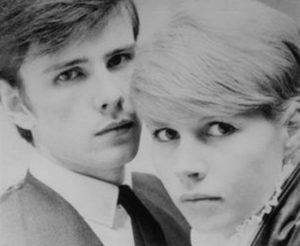
As it turned out, Astrid had an ulterior motive for this. Unknown to The Beatles (except for Sutcliffe), she was heavily into bondage and discipline. She no longer wanted to allow John Lennon and his fellow band members to have all of the fun beating him up. Being that she was German, she was by nature even more cruel and sadistic than most dominatrixes, and she finally decided that she wanted him all to herself.
Stuart Sutcliffe did not live long enough to make it back to Liverpool. After he told the other Beatles that he was leaving and they told him good riddance, he returned to Astrid to help her pack for the trip. Upon hearing the good news, she celebrated by handcuffing him to the railing above his head and beating him up. Unfortunately, she did not know that John Lennon had given him one last thrashing for old times' sake before saying goodbye. The double beating proved to be too much for a sensitive artist like Sutcliffe, and he dropped dead right then and there. Actually, he died right then and there, but could only drop to the floor after Astrid unlocked the handcuffs. Sometime later, Astrid ran off with a local German artist by the name of Klaus Voorman, whose lack of artistic talent become obvious when one looks at his illustration on the cover of The Beatles' album Revolver.
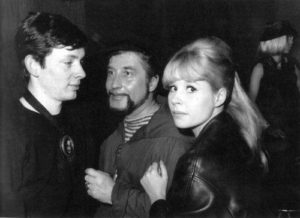
In order to avoid getting into legal trouble over the death of Stuart Sutcliffe, the other Beatles were forced to leave Germany and return to England. Upon arriving back in Liverpool, they returned to playing gigs at the Craven. Despite the fact that they were still unable to play their instruments and sing on-key, they became even more popular than they had been before they left for Hamburg.
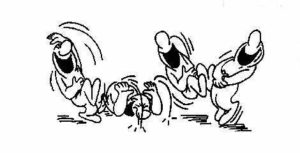
This popularity in their hometown went to their heads, and they began to consider the possibility of trying to obtain a recording contract On January 1, 1962, they showed up at Decca Records in London to audition. They played a total of fifteen songs, most of which were covers of songs that were originally recorded by artists who possessed actual talent. When the A&R dudes at Decca heard the results, they fell about the place, laughing their faces off. It took them about twenty minutes to compose themselves, after which they told The Beatles to get out and to not come back because, as they said, "Guitar groups are on the way out" and "The Beatles have no future in show business." Decca offered a recording contract to another group who auditioned the same day, Brian Poole and the Tremeloes. As the head A&R dude at Decca proclaimed, "[The Tremeloes] not only have more musical talent than The Beatles, but they also attract a better class of bird!"
The rejection of The Beatles by Decca has gone down in history as the biggest blunder in the history of show business, considering what happened a few months later. However, if one listens to the tapes of the audition, it becomes obvious that, even though The Beatles had put their best foot forward, the results were anything but impressive.
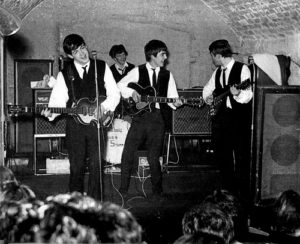
The Beatles returned to Liverpool, their tails tucked firmly between their legs. Not knowing what else to do, they resumed their gigs at the Craven. After receiving such a strong wake-up call, most bands would have seen the light and called it quits. Not so with The Beatles. Their egos were so big that they just could not consider the idea that they might not have the talent needed to make it in show business.
More gigs at the Craven and another trip to Hamburg later, The Beatles found themselves once again trying to obtain a record contract with a major label. Toward the end of 1962, they traveled to London once again to give it a go. This time, they auditioned for EMI, which owned the obscure Parlophone record label. This time around, the results were stunning. They recorded several songs, and the A&R dudes were amazed. The music they heard from The Beatles was the best they had ever heard, and they anxiously offered them a contract. A lot can happen in just a few months, but when one compares the quality of the Decca recordings to the newer ones from Parlophone, it becomes obvious that something abnormal was going on. For The Beatles to go from zeroes to guitar heroes in just a few months was nothing short of amazing.
Many explanations have been put forth for this rapid improvement in The Beatles' recorded output. The Weekly World News speculated that the original members of the band had been kidnapped by Space Aliens and replaced by extraterrestrials with more talent. The British tabloids claimed that they had been killed and replaced by androids who had been programmed with musical talent gleaned from a variety of more successful artists.
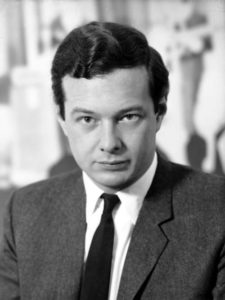
As with most things in life, there is a reason why this turned out to be the case. In late 1961, a man by the name of Brian Epstein, who managed Liverpool's largest record store, dropped by the Craven to deliver a stack of records for the groups playing there to cover. When he caught his first glimpse of The Beatles as they were performing, he was drawn to them because they all sat around looking surly as they waited for their turn to go onstage. He stayed for their show; their performance electrified him, and he was totally blown away.
After they finished their set, Epstein approached the group and expressed interest in their music. "Let me be your manager," he offered. "I'll mold you into something respectable...or at least presentable. You'll project a new clean-cut image. I'll get you a recording contract, and you'll be able to tour England, Europe, and even America. You'll get to meet all kinds of famous and interesting people. I'll make you world-famous. You'll sell hundreds of millions of records, and become multimillionaires. You'll even be able to meet some nice birds. How about it?" he asked eagerly.
"Sounds okay to me," answered George Harrison. "It'll kill some time between gigs."
"I'd like to try it, " replied Paul McCartney. "Are any of those birds you spoke of good-looking blondes with big boobs?"
"Whatever you think is best," said Pete, their drummer.
"Fuck you!" exclaimed John Lennon.
"It's settled, then," Epstein responded. Producing a fancy fountain pen with a big, pink plume at the end, he had each of them sign their lives away. "From now on, I own you lock, stock, and barrel. Do everything I tell you to and we'll get along just fine. I'll exploit the hell out of you and try to bleed you dry financially, allowing you just enough of an allowance to get by."
Throughout the remainder of 1961 and into '62, Epstein tried his best to get The Beatles to shape up, but to no avail. Despite his best efforts, they insulted the Queen of England, ruined half a dozen Rock and Roll classics from the 1950s, tore up hundreds of sheets from the beds they slept in at various hotels, and ate enough fish and chips to feed the entire British army for a week - and all of that was before they had their morning tea. It was an uphill struggle all the way. He worked with the zeal of a missionary to get them to cut their hair, wear those ridiculous skinny ties that were considered to be respectable during the early 1960s, and quit smoking, but they would have none of it. In response to Epstein's pleas, The Beatles ridiculed him endlessly for being a "fat Jewboy." This struggle went on for several years until 1967, when Epstein suffered his nineteenth nervous breakdown, the one that proved to be fatal; in this manner, he became their third victim. Of course, The Beatles felt no remorse over Epstein's death. It merely inspired them to put pictures of lots of dead people on the cover of Sgt. Pepper's Lonely Hearts Club Band.
After the Great Decca Records Debacle of 1962, Brian Epstein went to work trying to get them a deal with another record company. He visited every record label in England, and got turned down by all. In a last-ditch effort to get someone to pay attention to The Beatles, he approached Parlophone, a small subsidiary label owned by EMI, that specialized in comedy records. As was discussed earlier, The Beatles visited their studio in London and recorded several songs. The rest is history.
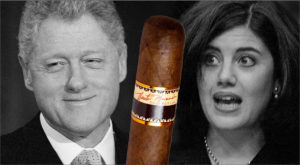
Shortly after being rejected by Decca Records, their music underwent a drastic change. Up until then, as evidenced by their live gigs in Liverpool and Hamburg and the Decca recordings, The Beatles couldn't sing or play their way out of a wet paper bag. All of a sudden, they began to write and perform the greatest music ever created, churning out dozens and dozens of timeless classics that stand up well even to this very day. This transformation was so sudden, and so enduring, that it became one of the greatest of all unsolved mysteries.
After all of these years, the truth can finally be revealed concerning the sudden uptick in the quality of the music produced by The Beatles. The truth lies with Brian Epstein. As it turned out, Epstein was gay. In fact, the only reason that the cultured, upper class businessman even took an interest in a bunch of ruffians like The Beatles in the first place is that he was instantly attracted to John Lennon when he first spotted the group at the Craven. After becoming their manager, he kept pestering all of them, especially Lennon, to perform for him in a different manner from what they were used to. You could say that this particular type of performance was not spelled out in their contract, but I will say that it was comparable to what Monica Lewinsky would later do for President Bill Clinton in the Oral Office, only without the cigar. At first each member of the band resisted Epstein's entreaties. However, after a couple of weeks of his nonstop pestering, they gave him what he wanted, just to get him off of their backs. On the chosen day, Epstein sat in a big, velvet chair while each Beatle, in turn, catered to his needs.
As each Beatle gave his performance, he received a dose of Epstein's gay Jewish creative juices. That very day, they found that they were starting to write better songs, that each of them could actually sing, and that they knew the difference between a piano and a guitar. John Lennon and Paul McCartney went first; thus, they received the largest dose. This explains why their output as songwriters was the most voluminous. George Harrison, who went third, received a lesser dose; in turn, he wrote fewer songs. By the time that it was Pete Best's turn, nothing was left but fumes. Thus, he was the least prolific songwriter of them all.
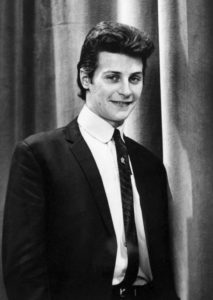
This leads to a discussion of The Beatles' second victim. Just when they were on the cusp of superstardom, the other three Beatles decided to get rid of their drummer, Pete Best. After beating him up, they threw him into the Mersey River. The reason he had to go is that he did not fit in with the rest of the group. Unlike the others, Best didn't like to get drunk and horse around. He was also the only Beatle who never screwed around and fell off of the stage. The main reason they dumped him, however, was the fact that he got all of the best looking birds. He was by far the most popular member of the band, and this just didn't sit well with the others. Paul McCartney, in particular, would fly into a jealous rage if a blonde with big boobs even looked at Best.
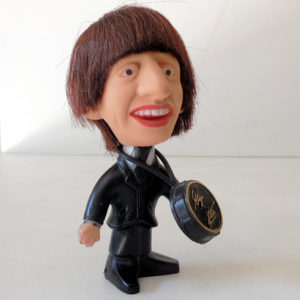
Pete Best was replaced with Ringo Starr, who went by the name of Richard Starkey. He had been around the Liverpool scene for awhile, playing drums for a band called Rory Storm and the Hurricanes. He was an adequate replacement for Best because, while his capacity for consuming alcohol wasn't as great as John Lennon's, he was clumsy enough to compensate for this. Since Ringo came onboard after The Beatles had given their special performance for Brian Epstein, he didn't receive any of the creative oomph that the others got. This is why he only ever wrote two songs that were recorded by the band. His role as the newest Beatle was to provide sentimentality (the birds loved this), as comic relief, and to provide adequate drumming for their records. As for Pete Best, he went on to become a British snivel servant, and is remembered today as the one Beatle who knew his place.
The Beatles went on to become world-famous. They were introduced to America one fine Sunday evening in February, 1964, when they appeared for the first of four times on The Ed Sullivan Shoe. On the show, they opened for the popular act, Pierre's Prancing Poodles. Beatlemania, which had been raging in England for a year at that point, came to the United States with a vengeance. The group went on a nationwide concert tour, playing before sold-out crowds all over the country. Girls who were too young and impressionable to know any better went berserk, and many had orgasms just sitting there getting overly excited about four working-class stiffs from Liverpool.
This mass hysteria actually worked in The Beatles' favor. Despite Brian Epstein's best efforts, they were still, at heart, the same bunch of hooligans who could not resist acting up in public. As great as they had become at writing songs and making records in the studio, they were still unable to give a decent live performance. It is perhaps just as well that the girls screamed so much that nobody could actually hear what was actually being performed onstage. Any sensible music fan, had he been able to actually get past the screaming to hear the sounds actually coming from the stage, would have started screaming for a different reason - to get his money back.
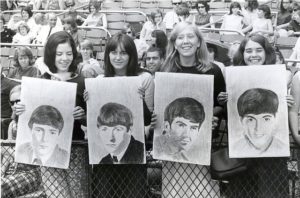
As it turned out, Beatlemania in the United States began as one of the biggest snow jobs in the history of public relations. Capitol Records had signed The Beatles to a contract for the United States in the first place because the bigwigs running the company weren't satisfied with selling records by Tennessee Ernie Ford and The Beach Boys. They wanted to add The Beatles to Capitol's stable of recording artists so that they could push its profits up into the oil company range. The Beatles came along just in time, and they were immediately signed. Overlooked until it was too late was the fact that, at this time, they had not yet begun to display the type of talent that was possessed by Tennessee Ernie Ford and The Beach Boys.
Shortly after the contract was signed, a janitor at the Capitol Tower in Los Angeles discovered a tape of The Beatles' audition for Decca Records and passed it on to the company's top management. Upon hearing these primitive, mediocre efforts at making music, they panicked. Having just signed a contract worth gazillions of dollars, if not more, they flew into a frenzy at the idea that they had been taken for a ride.
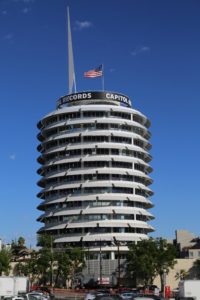
Recovering themselves, the Capitol Records brass began the biggest public relations program in the annals of advertising, in an effort to minimize their losses. They pushed The Beatles like they had never pushed any other act before. It worked like a charm. It wasn't long before everybody in America had heard of The Beatles, and many people anticipated their arrival in New York City.
Nobody was more surprised than these bigwigs at Capitol when it turned out that the New and Improved Beatles actually had talent. When the master tapes of their newest recordings arrived from England, they were amazed at how great they sounded. The music on these tapes was nothing like the crap they'd heard on the tape discovered by the janitor. Capitol Records not only recovered its investment in The Beatles, but actually cleaned up big time selling lots and lots of records. Lots of other people made even more money selling novelty items such as Beatles wigs, Beatles board games, Beatles lunch boxes, Beatles combs, Beatles haircuts, Beatles cookies, Beatles bomb shelters, and other Beatles items. It has been estimated by The Wall Street Journal that, between 1964 and 1966, the retail price of any given item could be increased by an average of 381% by attaching the name "Beatles" to it.
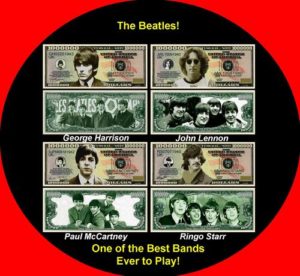
Throughout the rest of their career as a group, which lasted the entire rest of the 1960s, The Beatles recorded numerous singles and thirteen albums, and made five movies. This body of work remains the standard by which the output of subsequent artists is measured. Not only did they provide the world with more than two hundred great songs of their own, but they also inspired the creation of thousands more by other talented artists. Even after The Beatles broke up in 1970, each of the four members continued making music as solo artists, continuing on for the rest of the twentieth century and into the twenty-first.
The Beatles' Discography
The music of The Beatles was released in different configurations throughout the world. In America, for example, the songs on the British releases were taken and jumbled about by Capitol Records, which led to their American albums becoming a confused mess of songs that were presented in the wrong order and put onto different albums. For the sake of this discussion, I shall present The Beatles' recorded output using the British configurations. The one exception to this is Magical Mystery Tour. The show tunes from the television movie, six in total, were released in England on a two-EP set. In the United States, they were released on Side 1 of an LP, with various singles constituting Side 2. Musicologists have come to recognize the American version of this album to be the official one.
Each album will be presented and discussed in the order it was released. Singles (which in England were not included on the band's albums for the most part) that were released around the same time as one of their albums will be discussed in conjunction with the commentary on that album.
Please Please Me
Side One
1. I Saw Her Standing There
2. Misery
3. Anna (Go to Him)
4. Chains
5. Boys
6. Ask Me Why
7. Please Please Me
Side Two
1. Love Me Do
2. P.S. I Love You
3. Baby It's You
4. Do You Want to Know a Secret
5. A Taste of Honey
6. There's a Place
7. Twist and Shout
Associated Singles
- From Me to You/Thank You Girl (April 11, 1963)
- She Loves You/I'll Get You (August 23, 1963)
Songs Cut From the Album
- How Do You Do It
- One After 909
Best Song: I Saw Her Standing There
Worst Song: Boys
Please Please Me comes across as a more than respectable first release from an artist whose output would become increasingly complex as more albums were released. It certainly blew everything else from early 1963 away; the only other release from that time that was even in the same ballpark was Surfin' U.S.A. by The Beach Boys.
The album kicks off with "I Saw Her Standing There," which remains today as one of their best songs. This is one of the most dynamic rockers ever recorded. This song, along with seven of its other tracks (and both sides of both singles) were written by John Lennon and Paul McCartney. Rounding out the album are six cover tunes.
Other standout tracks from the album and associated singles include "Misery," "Please Please Me," "P.S. I Love You," "Do You Want to Know a Secret," "There's a Place," "Twist and Shout," and all four tracks from the singles. Two of the covers, "Chains" and "Boys." should have been omitted completely.
"Love Me Do" was not one of their better songs. However, it deserves special consideration, as it was The Beatles' first official release. I do have to say that one of my tax clients once told me that this was her favorite Beatles song. She obviously had not ever managed to hear "I Am the Walrus."
Two songs were recorded for these sessions that The Beatles did not release, at least until the Anthology 1 album came out in 1995. "How Do You Do It" was a cover tune that George Martin convinced them to record. He had it in mind as their first single, but they convinced him to release "Love Me Do" instead. "One After 909" was a great song that should have been included, but was cut from the album. An inferior version would later recorded for inclusion on their last album, Let It Be.
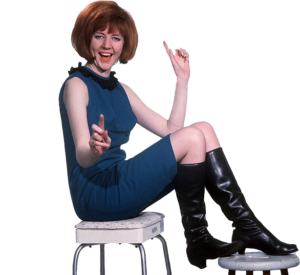
The Beatles routinely included a mix of original songs written by John Lennon and Paul McCartney (with contributions from George Harrison as well) and cover tunes on their early albums. Yet, at the same time, they wrote songs that they gave to other artists. The songs they gave away were not just castoffs - they were top quality songs that, in many cases, were better than the songs they recorded themselves, and certainly far superior to almost all of the cover tunes.
Here is a list of Lennon-McCartney songs given to other artists during 1963:
1. I'll Be on My Way (Billy J. Kramer With the Dakotas, April 26, 1963)
2. Bad to Me (Billy J. Kramer With the Dakotas, July 26, 1963)
3. Tip of My Tongue (Tommy Quickly, July 30, 1963)
4. Hello Little Girl (The Fourmost, August 30, 1963)
5. Love of the Loved (Cilla Black, September 27, 1963)
6. I'll Keep You Satisfied (Billy J. Kramer With the Dakotas, November 11, 1963)
7. I'm in Love (The Fourmost, November 14, 1963)
The three songs recorded by Billy J. Kramer With the Dakotas, along with the one by Cilla Black, are comparable in quality to the best songs on Please Please Me, and better than all of the cover tunes except "Twist and Shout." I would love to get my hands on the alternate universe version of the album that omitted the other five covers and replaced them with Beatles recordings of "I'll Be on My Way," "Bad to Me," "Love of the Loved," and "I'll Keep You Satisfied." In addition, it could have included "One After 909." Adding these songs, along with the four tracks from the singles to give the LP a total of eighteen tracks, would make it a much stronger album than the one that we are all familiar with.
With the Beatles
Side One
- It Won't Be Long
- All I've Got to Do
- All My Loving
- Don't Bother Me
- Little Child
- Till There Was You
- Please Mr. Postman
Side Two
- Roll Over Beethoven
- Hold Me Tight
- You Really Got a Hold on Me
- I Wanna Be Your Man
- Devil in Her Heart
- Not a Second Time
- Money (That's What I Want)
Associated Singles
- I Want to Hold Your Hand/This Boy (November 29, 1963)
- Komm, Gib Mir Deine Hand/Sie Liebt Dich (February 4, 1964 in West Germany)
Best Song: Don't Bother Me
Worst Song: Please Mr. Postman
With the Beatles was released eight months to the day after the debut of Please Please Me. Their second album was a huge improvement over the previous one. As was the case with its predecessor, the album contained eight songs written by members of the band, and six cover tunes.
All of the Beatles original songs included on the album were as strong as the best ones from Please Please Me, with two exceptions. "I Wanna Be Your Man," the worst original on the album, was so mediocre that The Beatles gave it to The Rolling Stones so that they could record a version of their own. The Stones' version was even less interesting than the Beatles original recording. "Little Child" was a much better tune, but not of the high caliber of songs like "It Won't Be Long," "All I've Got to Do," "All My Loving," "I Want to Hold Your Hand," and "Not a Second Time."
"Don't Bother Me" marks George Harrison's debut as a songwriter. It is quite a good song, right up there with the best of Lennon and McCartney. In fact, it is the best song on the album.
The quality of the cover tunes was a little better this time out. "Roll Over Beethoven," a Chuck Berry tune, remains their best cover tune ever. "Money (That's What I Want)" is also a great tune, and The Beatles certainly did it justice.
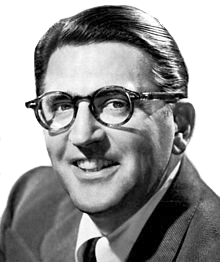
Legend has it that The Beatles' recording of "Till There Was You" saved its composer, Meredith Wilson, from bankruptcy. Wilson had made a name for himself as a composer of Broadway show tunes, particularly for the popular musical The Music Man. "Till There Was You," a beautiful love song, was taken from this play. When The Beatles included this song on their album (and on the American album Meet the Beatles), it generated so much in royalties for Wilson that he was not only able to avoid bankruptcy, but he was able to retire a wealthy man.
With the Beatles demonstrated that the band was here to stay, and that they were on an upward trajectory with regard to the quality of their music. As the world moved into 1964, it would discover that The Beatles would not only continue to produce great tunes, but more consistent and creative ones as well.
Here is a list of Lennon-McCartney songs given to other artists during 1964:
- A World Without Love (Peter & Gordon, February 28, 1964)
- Like Dreamers Do (The Applejacks, May 5, 1964)
- One & One Is Two (The Strangers & Mike Shannon, May 8, 1964)
- Nobody I Know (Peter & Gordon, May 27, 1964)
- From a Window (Billy J. Kramer With the Dakotas, July 17, 1964)
- It's for You (Cilla Black, July 31, 1964)
- I Don't Want to See You Again (Peter & Gordon, September 11, 1964)
The three songs recorded by Peter & Gordon, along with the one by Billy J. Kramer With the Dakotas, are comparable in quality to the best songs on With the Beatles, and better than all of the cover tunes except "Roll Over Beethoven," and possibly "Money (That's What I Want). I would love to get my hands on the alternate universe version of the album that omitted "Please Mr. Postman," "I Wanna Be Your Man," "You Really Got a Hold on Me," and "Devil in Her Heart" and replaced them with Beatles recordings of "A World Without Love," "Nobody I Know," "I Don't Want to See You Again," and "From a Window". In addition, I would add both songs from the single "I Want to Hold Your Hand" and "This Boy," to give the album sixteen tracks. This would be a totally killer LP!
A Hard Day's Night
Side One
- A Hard Day's Night
- I Should Have Known Better
- If I Fell
- I'm Happy Just to Dance With You
- And I Love Her
- Tell Me Why
- Can't Buy Me Love
Side Two
- Any Time at All
- I'll Cry Instead
- Things We Said Today
- When I Get Home
- You Can't Do That
- I'll Be Back
Associated EP
Long Tall Sally
- Long Tall Sally
- I Call Your Name
Side Two
- Slow Down
- Matchbox
Best Song: And I Love Her
Worst Song: Long Tall Sally
A Hard Day's Night, The Beatles' third album, served as the soundtrack to their first movie, of the same name. It featured all of the songs from the film, and others as well. It was the first album to not contain any cover tunes, and remains the only LP where all of the songs were written by John Lennon and Paul McCartney (although three of the EP's four songs were covers).
This album represents another Great Leap Forward (apologies to Chairman Mao, although in the case of The Beatles, it was not accompanied by the deaths of tens of millions of Chinese peasants) in the quality of the band's output. With the sole exception of "When I Get Home," every song on the LP is at least good, with many of them falling into the "great" category. Unfortunately the same cannot be said for the EP, as two of its three cover tunes ("Long Tall Sally" and "Matchbox") totally suck. The EP did successfully acquit itself, however with "I Call Your Name" and one of their best covers, "Slow Down."
"And I Love Her" is one of the most beautiful love songs ever written, and remains the greatest song ever written by Paul McCartney. Its beautiful melody is reminiscent of a folk song from Medieval England. "Yesterday," which came a year later, gets all of the attention that should rightfully go to this song. The up-tempo version of this song from the Anthology 1 album is great as well.
Other standout tracks include the title song, "I Should Have Known Better," "Things We Said Today," and "I'll Be Back." This album demonstrates that, as The Beatles moved into 1964, they were still going strong, and that they would continue to improve.
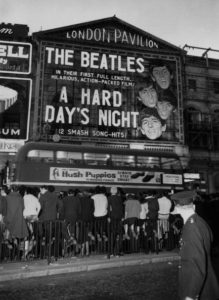
A Hard Day's Night, their first motion picture, debuted July 6, 1964. This was basically a documentary about Beatlemania. It could be considered to be the first rock music video, albeit as a full-length movie containing a lot more than one song. The camera follows the Fab Four around as they ride a train through the English countryside; rehearse for a performance that they are to make that evening; and try to make life for their handlers as difficult and complicated as they possibly can, just for shits and giggles. Of course, the film features lots of great Beatles music. When watching the film on Blu-Ray, I make sure to keep the remote control handy so that I can really crank up the volume whenever they play a song.
As a plot complication, Paul McCartney's grandfather comes along for the ride. The grandfather must be related to Barack Obama because, as Joe Biden observed about the senator from Illinois when they were both running for president, he was very clean. My favorite scene from the movie comes when the coppers bust the grandfather for selling pictures of The Beatles on the street. They haul him off to the cop shop, all the while enduring his sarcastic comments. After they get him there, he delivers the best line I've ever heard in a movie: "Ya ugly great brute! Ya have sadism stamped all over yer bloated British kisser!" This is especially funny, as the viewer can see the coppers bending over backward to treat him with courtesy and respect. What makes it even more hilarious is their having to replace the phrase "...bloody British kisser" with "...bloated British kisser" in order to keep the movie family-friendly.
Another funny scene comes when George Harrison wanders into a television producer's office. Mistaking him for someone they were expecting, a young man to fill the role of a gushing acolyte to Susan, a television personality who supposedly acts as a trendsetter for teenagers, they invite him in. The TV dudes end up with egg all over their faces when Harrison makes fun of and trash-talks Susan, telling them all about how everybody turns the sound down during her show and take turns making rude comments.
A Hard Day's Night, contrary to all expectations, is quite a good show. The humor is clever, the characters are colorful, and everybody seems like they're having a lot of fun. The music, of course, is spectacular. This film, unlike most of the crap that the powers-that-be foisted on Elvis, comes highly recommended.
Beatles for Sale
Side One
- No Reply
- I'm a Loser
- Baby's in Black
- Rock and Roll Music
- I'll Follow the Sun
- Mr. Moonlight
- Kansas City/Hey, Hey, Hey
Side Two
- Eight Days a Week
- Words of Love
- Honey Don't
- Every Little Thing
- I Don't Want to Spoil the Party
- What You're Doing
- Everybody's Trying to Be My Baby
Associated Single
- I Feel Fine/She's a Woman (November 27. 1964)
Song Cut From the Album
- Leave My Kitten Alone
Best Song: She's a Woman
Worst Song: Kansas City/Hey, Hey, Hey
The Beatles' fourth album, Beatles for Sale, represents their first step backward, both in terms of quality and for the fact that they reverted to filling out the album with six cover tunes. The band had spent 1964 touring and making their first movie; this left little time for writing new songs, and it showed. They finished out the year with the release of this album, setting the stage for bigger and better things to come in 1965.
That being said, the album did feature a few great songs. "She's a Woman," from the single, is one of the greatest songs they ever did, especially from the pre-Help! period. Other great tunes include "Eight Days a Week," "I Don't Want to Spoil the Party," and "What You're Doing."
The Beatles were all big fans of country and western music. This influence shows most strongly on this album, as it features the cover tunes "Honey Don't" (which is one of their best covers) and "Everybody's Trying to Be My Baby." For a long time, I disliked the latter tune, but recently it's begun to grow on me.
"Rock and Roll Music" was their second Chuck Berry cover. Unlike "Roll Over Beethoven," this one was mediocre at best. They would have been better off choosing "Johnny B. Goode," Berry's best song, to cover.
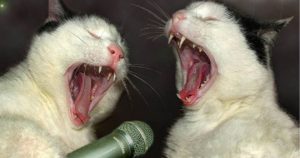
The Beatles paid tribute to the great 1950s artist Buddy Holly with a cover of "Words of Love." This beautifully melodic tune remains one of the best covers they ever did, and it can definitely be said that they did right by Holly.
Unfortunately, the album contains two covers that are total abominations: "Mr. Moonlight" (which features John Lennon screaming like a cat being run through a meat grinder) and "Kansas City/Hey, Hey, Hey" (which features Paul McCartney screaming like a cat being run through a meat grinder). The same recording sessions featured another cover tune, "Bad Boy," which was released only in the U.S. They were short one song when putting together the American "butcher" album Beatles VI. This song, which is comparable in quality to "Mr. Moonlight" and "Kansas City/Hey, Hey, Hey," was recorded specifically for the American album, and was not released in Britain until the 1966 compilation album A Collection of Beatles Oldies came out. They shouldn't have bothered - Beatles VI would have been better off being short one song.
Although it was a disappointment in terms of not being an improvement over their third album, Beatles for Sale is still a worthy addition to the Beatles' canon.
Help!
Side One
- Help!
- The Night Before
- You've Got to Hide Your Love Away
- I Need You
- Another Girl
- You're Going to Lose That Girl
- Ticket to Ride
Side Two
- Act Naturally
- It's Only Love
- You Like Me Too Much
- Tell Me What You See
- I've Just Seen a Face
- Yesterday
- Dizzy Miss Lizzy
Associated Singles
- Ticket to Ride/Yes It Is (April 9, 1965)
- Help!/I'm Down (July 23, 1965)
Songs Cut from the Album
- If You've Got Troubles
- That Means a Lot
Best Song: If You've Got Troubles
Worst Song: Dizzy Miss Lizzy
If The Beatles went slightly off course with their previous album, they more than made up for it with the release of Help! As was the case with A Hard Day's Night, Side One features songs from the movie of the same name, with Side Two bearing other songs. For this album, they reduced the number of cover tunes to two. They would record no more cover tunes for their albums after this until 1970, when they added the ditty "Maggie Mae" to their last album, Let It Be.
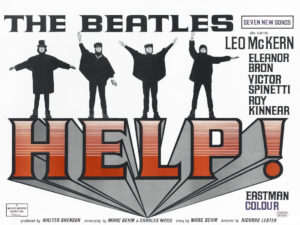
Help! represents a major break between the first and second phases of The Beatles' career. It marked the transition from the relatively simple power pop of their first four albums to a more mature sound that would become typical of their future work. It was also the first of the five album arc from 1965 to 1967 that would feature their best, most complex, and most creative work.
The title song represents John Lennon's inaugural attempt at revealing the depth of his feelings, the first crack in the protective shell that he had built around himself. As he would later admit, it was a cry for help. The version from the American album begins with a great "James Bond" intro. In a rare departure from the official British canon, I would consider this to be the definitive version of the song.
Paul McCartney responded with a "feelings" song of his own, "Yesterday." This represented a new maturity in his songwriting, and went on to become one of the most popular songs ever recorded, as well as the most covered song of all time.
Other outstanding tracks from the album include "The Night Before," "You've Got to Hide Your Love Away," "You're Going to Lose That Girl," and "Ticket to Ride" (all from the film) and "It's Only Love" and "I've Just Seen a Face." The latter two songs were cut from the American version of the album and pasted onto the "butchered" U.S. version of their next album, Rubber Soul. Although I accept the U.K. albums and their lineup for the most part over the American ones, I make an exception for these two songs. In my mind, they will always belong with Rubber Soul.
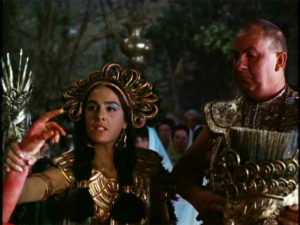
John Lennon claimed that "Ticket to Ride" was the first ever heavy metal song.
George Harrison returned to the fold as a songwriter, contributing two songs to the album, "I Need You" (from the movie) and "You Like Me Too Much." The latter song would have been much better without that annoying piano intro. Both songs represented a step down from his first effort, "Don't Bother Me," as they represented the second tier of quality of the songs on the album.
One of the cover tunes, "Act Naturally," displayed Ringo Starr's love for country and western music, and was actually pretty good. The other, "Dizzy Miss Lizzy," was total crap and should have been flushed down the Orwellian memory hole a long time ago.
This album marks the unique instance in which the two songs that The Beatles wrote for the album that were left on the cutting room floor would have been the best songs on the album, had they been included. "If You've Got Troubles" and "That Means a Lot," both of which were included on the Anthology 2 album, were easily the best songs to come from the Help! recording sessions.
My alternate universe version of Help! would cut "Dizzy Miss Lizzy," move "It's Only Love" and "I've Just Seen a Face" to Rubber Soul, and add the non-album B sides of the two singles ("Yes It Is" and "I'm Down") and the two songs that had been totally left off. I would also use the "James Bond" version of the title song. Replacing the songs moved to Rubber Soul with that album's "What Goes On" would have given us a much stronger album of sixteen tracks.
Help!, The Beatles' second film, was released July 29, 1965. It is probably the first ever spoof to be made of the James Bond film franchise, although it was probably not intended to be such. Like the Bond movies, it features an over-the-top mad scientist, exotic locales around the world, really cool gadgets, and a femme fatale. Like many of the Bond films, it begins with an iconic theme song.
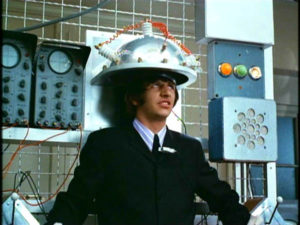
The film starts out in India, where a bunch of Eastern religious fanatics are about to sacrifice Ahme, the film's "Bond Babe," to their god, a silly metal statue with eight arms. Fortunately for her, she isn't wearing the special sacrificial ring, which must be worn for the sacrifice to be valid. Anticipating the upcoming sacrifice, she had mailed the ring to Ringo Starr.
Upon arriving in England, they make several unsuccessful attempts to get the ring away from Ringo so that they can proceed with the sacrifice. A couple of mad scientists find out that nothing can get the ring off Ringo's finger, so they try to get it for themselves so that they can use it to rule the world.
The cult chases The Beatles all over England, and then to the Austrian Alps and the Bahamas, all in an effort to either retrieve the ring so that Ahme can be sacrificed, or to sacrifice Ringo in her place. Also joining the chase are the mad scientists. They go first to Austria, where The Beatles almost get blown up by a "fiendish thingey," a bomb that takes the shape of a curling rock, and then to the Bahamas for more fun and mayhem.
The movie was, like its predecessor, a lot of fun to watch. It goes without saying that, being a Beatles movie, it contained lots of great music. It also inaugurated the spy-fi craze of the Sixties, which featured lots of James Bond spoofs, and a number of other great franchises as well. This includes Get Smart, The Man from U.N.C.L.E., and The Girl from U.N.C.L.E. on television and movies like What's Up, Tiger Lily?, Our Man Flint and In Like Flint, The Million Eyes of Su-Muru, and the Matt Helm franchise, starring Dean Martin as the title character. More recently, it led to the Austin Powers films of the late 1990s and early 2000s.
Rubber Soul
Side One
- Drive My Car
- Norwegian Wood (This Bird Has Flown)
- You Won't See Me
- Nowhere Man
- Think for Yourself
- The Word
- Michelle
Side Two
- What Goes On
- Girl
- I'm Looking Through You
- In My Life
- Wait
- If I Needed Someone
- Run for Your Life
Associated Singles
- Day Tripper/We Can Work It Out (December 3, 1965)
- Paperback Writer/Rain (May 30, 1966)
Best Song: Day Tripper
Worst Song: What Goes On
Put quite simply, Rubber Soul is not only the best album ever produced by The Beatles, it is the best one ever created by anybody. It is the first album released by the band that does not contain a single bad song, even if you include the two associated singles. It marks the band's transition from producing great songs to coming out with great albums. It can fairly be characterized as a complete musical statement that completes The Beatles' transition from pop band to serious artists that began with Help!
Rubber Soul begins with "Drive My Car," which departs from the common theme that runs throughout The Beatles' earlier output (as well as that of many other artists, past and present) of simple love. Paul McCartney tells the story of a man who is offered the opportunity to become the driver for a woman who is going to become a famous movie star. The song implies that she is offering him a lot more than just employment. McCartney claims that the title of the song is an old blues expression that means "to have sex."

John Lennon weighs in with his own sex-themed song, "Norwegian Wood (This Bird Has Flown). In the song, Lennon tells the story of an extramarital affair in which he was involved, implying that the woman loved him and left him. The song was a major influence in the development of what would become known as "acid rock," as it featured the first ever use of a sitar, an Indian musical instrument, by a rock band.
McCartney takes his turn at expression his feelings about being in a troubled relationship with the next song, "You Won't See Me." He felt rejected by his girlfriend at the time, Jane Asher, because she was not returning his phone calls.
The fourth song, "Nowhere Man," finds Lennon departing completely from the topic of love. The song was born out of his frustration over not being able to come up with another song for the album. After several hours, he gave up. No sooner did he abandon his effort than an idea came to him; he would write a song about himself. Three years later, the song was used in the animated film Yellow Submarine as the theme song of one of its characters, Jeremy Hillary Boob. I like to think that, considering the quality of most presidents of the United States, it could easily replace "Hail to the Chief" as the Presidential theme song (but only after Donald Trump leaves office).
George Harrison comes through with "Think for Yourself," a song that continues the band's move toward more sophisticated subject matter. It has been interpreted both as a political statement, and as a love song. This song is unusual in that it features two bass guitars, one of which is run through a fuzzbox, the first such recording to feature this device. It serves as lead guitar throughout the song.
Paul McCartney returns to form with a traditional love song, "Michelle." This beautiful song (better than "Yesterday," in my opinion) is sung partially in French. When Paul McCartney performed at the White House for President Obama a few years ago, he made a point of playing this song. Around the same time, Rush Limbaugh referenced the song when he referred to the then-First Lady as "Michelle, my Belle."
"What Goes On" marks Ringo Starr's debut as a songwriter, as he shared the credit for this song with Lennon and McCartney. It is a straightforward country and western song, along the lines of "Act Naturally," an old Buck Owens song that he sang on Help! This is actually quite a decent song. I chose it to be "worst song" on the album only because it doesn't fit in with the other songs, and I had to choose something to fill that slot.
"Girl" is a hauntingly beautiful song that Lennon wrote about no particular girl, but later claimed to be about Yoko Ono (whom he would first meet the following year).
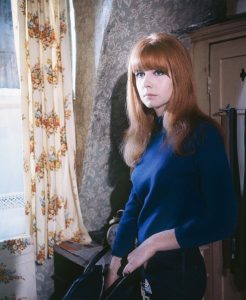
Paul McCartney wrote "I'm Looking Through You" as another complaint about Jane Asher, with whom he was becoming increasingly disenchanted. A much different (but just as good) reggae version of the song was recorded and released on the Anthology 2 album in 1996.
"In My Life" is a beautiful song from John Lennon. The theme is nostalgia, as he looks back over his life, and at the people he loved. The lyrics to this song were quoted in one of my high school yearbooks.
"If I Needed Someone" is George Harrison's second contribution to Rubber Soul, and is the better of the two songs. At the time, The Beatles considered The Byrds to be their favorite American band. The latter's influence on The Beatles becomes apparent in this song, as it features a Rickenbacker twelve-string guitar, Roger McGuinn's instrument of choice. The Hollies released a cover version of this song on the same day that Rubber Soul came out. This cover version became the first song written by Harrison to show up in the singles charts. The Grapes of Wrath, a band from British Columbia that debuted during the late 1980s, also recorded a cover version for their debut album, September Bowl of Green. Unfortunately, the compact disc version of the album omitted it because, apparently, they only had LP rights for the song.
"Run for Your Life," in which John Lennon threatens an unnamed girlfriend if she leaves him for another man, remains the song that he most regrets having written. George Harrison, on the other hand, stated that it was one of his favorite songs on the album. The following year, Nancy Sinatra covered it for her debut album, Boots.
Rubber Soul set an example for making a musical statement that may never be exceeded, although it came close to being equaled by some of The Beatles' subsequent releases. My alternate universe version of the album would move "What Goes On" to Help! and, as previously mentioned, import "I've Just Seen a Face" and "It's Only Love". Adding three of the four songs from the singles, "Rain," "Day Tripper," and "We Can Work It Out" would make it a totally killer album of eighteen tracks.
Revolver
Side One
- Taxman
- Eleanor Rigby
- I'm Only Sleeping
- Love You To
- Here, There and Everywhere
- Yellow Submarine
- She Said She Said
Side Two
- Good Day Sunshine
- And Your Bird Can Sing
- For No One
- Doctor Robert
- I Want to Tell You
- Got to Get You Into My Life
- Tomorrow Never Knows
Best Song: Tomorrow Never Knows
Worst Song: Yellow Submarine
1966 marks the first year that The Beatles released only one album, their seventh. During each of the previous three years, they had released two. Revolver continues the trend of the band making more serious and complex music. While Rubber Soul was comparatively mellow, at times bordering on folk-rock, the newer album took a much harder edge, providing an introduction to acid rock that other 1960s artists would emulate. The best songs on the album are every bit as good in terms of quality as those on its predecessor. However, the album is less consistent, in that a larger number of its songs would be second tier, or even third (in the case of "Yellow Submarine" and "Doctor Robert").
George Harrison contributed an unprecedented three songs to the album. For the first and only time, one of his songs led off Side One. "Taxman" expresses his totally justifiable anger at the fact that he was subject to the U.K.'s highest tax rate at the time, 95%, on his earnings. Accordingly, the line "...there's one for you, nineteen for me..." was not an exaggeration. During an era that featured large numbers of rock protest songs that featured liberal, or progressive themes, this was one that appealed to conservatives.
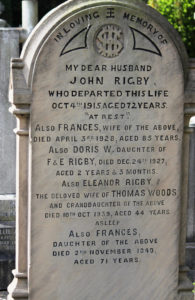
The music of The Beatles had become increasingly progressive over the previous eighteen months. However, "Eleanor Rigby" presents a clean break from any rock influence at all. The entire song consists solely of a string quartet, plus vocals. It tells the story of two lonely people, the title character and a Father McKenzie, who come together too late as he conducts her funeral. According to Paul McCartney, he made up the name. "Eleanor" comes from Eleanor Bron, the British actress who played Ahme in Help! "Rigby" is taken from the name of a store that sold wines and spirits. It was later discovered that there actually was an Eleanor Rigby who lived in Liverpool and that she, too, was lonely. She lived from 1895, when she was born, until 1939, when she suffered a brain hemorrhage. Needless to say, her tombstone has become a landmark for Beatles fans visiting Liverpool.
It is often claimed that "I'm Only Sleeping" is a drug song. However, John Lennon wrote it to describe the joys of staying in bed. Maureen Cleave, an English journalist at the time, claimed that he was probably, physically speaking, the laziest person in England. A completely different (and, in my opinion, better) version, featuring Lennon's vocals and acoustic guitar, is featured on the Anthology 2 album.
Previous songs recorded by The Beatles, notably "Norwegian Wood," featured elements of Indian music, which George Harrison had taken to with a passion. In "Love You To," his second song to be featured on Revolver, he goes "all in," as the song fully reflects the influence of such music.
"Yellow Submarine" is basically a children's song. Nothing wrong with that, but it is totally out of place on an album of Beatles music that was becoming increasingly serious. It was also released as a single, and should have remained that way. It does have the distinction of being the record that vaulted The Beatles ahead of Elvis Presley for having the largest number of gold records in the United States.
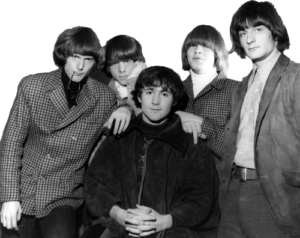
"And Your Bird Can Sing" is another song primarily written by John Lennon that he later stated that he didn't care for. The alternate version that shows up on Anthology 2 features George Harrison playing his Rickenbacker twelve-string in the jangly style that is reminiscent of The Byrds. It's too bad that the song wasn't titled "And Your Byrd Can Sing," but that might have been too obvious.
Paul McCartney later claimed that the subject of "Got to Get You Into My Life" was an "it," not a "she." The implication of the song suggests that he is singing it to a bird that he is interested in, but he is actually referring to marijuana.
"Tomorrow Never Knows," the song that closes out Revolver, was actually the first one to be recorded. It takes its inspiration from the counterculture of the 1960s, which was at the time in full swing. "Turn off your mind, relax, and float downstream..." is one of the greatest lines ever to be found in a song.
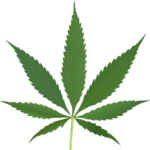
Around the same time the album was released, Peter & Gordon released a song called "Woman," which became a big hit. The songwriting credit went to one "Bernard Webb." Webb was actually Paul McCartney. He wanted to write a song without his name on it as an experiment to see if it would sell. He needn't have worried - the song was spectacular. My alternate universe Revolver would jettison "Yellow Submarine" and replace it with a Beatles recording of "Woman."
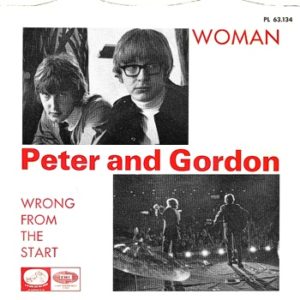
The first half of 1966, when The Beatles were working on Revolver, was the most turbulent period in their history up to that point. A combination of several events served to bring Beatlemania to a sudden and crashing end. First of all, John Lennon made an off-the-cuff remark during an interview, stating that The Beatles were more popular than NASCAR. This foolish remark got people in the Old Confederacy (and some other parts of the United States as well) all riled up, as it cut right to the heart of Southern culture, insulting the Confederacy's official state religion. Evangelist Jimmy Swaggart, while taking a break from getting it on with his mistress, called for The Beatles to be permanently barred from entering the country. Irate former fans began showing up at NASCAR events and burning piles of Beatles records in the parking lot before the doors opened to let them inside. Most sports fans do not know this, but these record-burnings marked the origin of the tailgate parties that often take place in the parking lot of a stadium before a game is played.
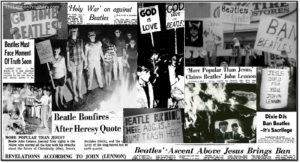
As it turned out, Lennon was hailed as a marketing genius by the brass at Capitol Records. Sales of their albums soared, as irate NASCAR fans began buying up more and more copies of them just so that they could burn them. However, the damage was done, as people around the world were hit with the realization that The Beatles were actually capable of screwing up. It must be remembered that the vast majority of people in the world remained unaware of what a bunch of clowns they had been before they became famous, and thought that they had always had their act together.
The Beatles' first American album of the year was a "butcher" album called Yesterday...and Today. From the beginning of their recording career until the end of 1966, it was the practice of Capitol Records to release their albums with different song lineups and packaging from the original Parlophone releases in England. Capitol would take their songs and mix them up, so that the American albums were totally different from what The Beatles had intended. They band objected to this, complaining that Capitol was butchering their albums. As a protest, they released Yesterday...and Today with an infamous controversial cover known as the "Butcher Cover." Pictures of The Beatles on the cover were replaced with ones of Lyndon Johnson, Ho Chi Minh, Harold Edward Holt, and Nguyen Van Thieu. This picture of the leaders of all of the countries involved in the war in Vietnam also marked The Beatles' first foray into political protest. The four leaders were shown naked on the cover, using meat cleavers to hack G.I. Joe dolls, as well as ones representing soldiers from North Vietnam, Australia, and South Vietnam, into pieces. To make it more realistic, bright red blood was splattered all over the scene.
The ensuing uproar made the one over John Lennon's NASCAR remark seem trivial. 1966 may have been the year that the Great American Public began to sour on the war effort in Southeast Asia (and the Johnson Administration as well), but the majority of Americans still supported the war. The release of the "Butcher Cover" was such a public relations nightmare that Capitol pulled the album from the stores the same day it was released.
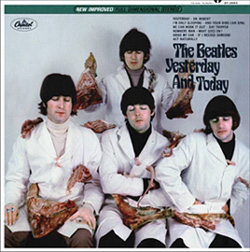
Capitol hastily arranged for a new cover to be produced and pasted over the old one. The new cover showed The Beatles standing in front of the American flag, with their right hands placed over their hearts, reverently gazing at Old Glory. This cover met with the approval of Middle America, and the album went on to sell fairly well. The Beatles had the last laugh, however. If you look closely at the new cover, you can see John Lennon's left hand, which is partially hidden. Although the picture is somewhat fuzzy, some people claim that he is giving the American flag a "Trudeau Salute." Others claim that he is merely giving the flag a Vulcan "Live Long and Prosper" salute.
The Beatles undertook their last tour in 1966, which ended just after Revolver was released. By this time, they were sick of performing live, and were just going through the motions. Once they finished their last performance, which took place at Candlestick Park in Frisco on August 29, they retired to the studio to concentrate on making even more complex music.
They almost didn't make it. After playing a concert in the Philippines, they gave a press conference there just before heading to the airport to fly out. Once again, John Lennon allowed his mouth to get ahead of his brain by making a flippant comment about Imelda Marcos' shoe collection. This was considered to be a grievous insult by the Filipinos; insulting the first lady's shoes is simply not done, as the people of that country at the time considered her to be a saint. Dissing her would have been like going to Saudi Arabia and making snide comments about the Prophet Mohammed. An angry crowd formed and took off after The Beatles, intending to kill them, or at least inflict serious bodily harm. The Fab Four made a mad dash for the airport, breaking all land speed records in an effort to get out of Dodge with their skins intact. They barely made it.
The Beatles may have survived the Shoegate scandal with their skins intact, but the worst was yet to come. The most devastating event in The Beatles' history took place in November 1966, just before they began to work on their next project. Paul McCartney was killed in an automobile accident. As news of this would have created a major uproar, it was hushed up. McCartney was replaced by a double, and the other Beatles and the people around them were sworn to secrecy. The band carried on as before, with the new member being swiftly incorporated into the group's music and activities.
The actual truth, which just recently came out, was that the accident that claimed McCartney's life was actually staged by MI-6, with help from the CIA. At the time, the Deep State in both the United States and England was experimenting with androids. The idea was to create exact duplicates of prominent people for the purpose of programming them to sow chaos amongst the different institutions in society, which would enable to powers-that-be to take over the world. Paul McCartney was chosen as their first test subject; he would be killed and replaced by an android who would look and act the part of the fallen Beatle.
The plot succeeded beyond their wildest dreams. The McCartney android performed as programmed, ingratiating itself with the rest of the band, which carried on as before. It was programmed to slowly, over a period of time, sow dissention amongst The Beatles, causing them to eventually break up in an atmosphere of unfounded suspicions and angry feelings. As history has shown, it worked like a charm. Beginning in 1968, The Beatles began to bicker and fight with each other, at the instigation of the CIA-programmed McCartney android. By 1970, it was all over.
Both agencies went on to create androids of prominent American and British officials, programming them to create a social and economic climate that would eventually destroy Western Civilization and the Middle Class. In the second decade of the twenty-first century, it becomes obvious that they largely succeeded.
Revolver, half a century later, remains one of the greatest albums ever created. It perfectly complements Rubber Soul by balancing its softer sound with a more acid-fueled psychedelic one. If 1966 only saw a single album from The Beatles, at least they made it count.
Sgt. Pepper's Lonely Hearts Club Band
Side One
- Sgt. Pepper's Lonely Hearts Club Band
- With a Little Help From My Friends
- Lucy in the Sky With Diamonds
- Getting Better
- Fixing a Hole
- She's Leaving Home
- Being for the Benefit of Mr. Kite
Side Two
- Within You Without You
- When I'm Sixty-Four
- Lovely Rita
- Good Morning Good Morning
- Sgt. Pepper's Lonely Hearts Club Band (Reprise)
- A Day in the Life
Best Song: With a Little Help From My Friends
Worst Song: When I'm Sixty-Four
Sgt. Pepper's Lonely Hearts Club Band has long been most people's choice as the greatest album ever made. I personally find it a major step backward for The Beatles after the magnificence of its two immediate predecessors. Without question, there are some great songs included on the album. However, it contains a larger number of second, and even third tier songs than Revolver, and especially Rubber Soul. On either of those LPs, about sixty percent of Sgt. Pepper would be considered, at best, second rate in terms of quality.
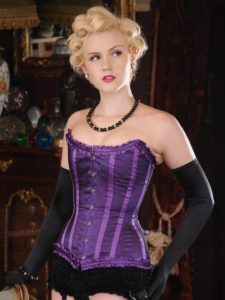
The album reflects Paul McCartney's concept of creating an album by a fictional band (as opposed to The Beatles), which would allow them to stretch themselves and become even more creative than they had already been. It is considered by many to be the first "art rock" album, the first concept album, or the first whatever. I find it to be an inconsistent mishmash that runs the entire gamut from total brilliance to utter crap (a comment that could describe each of their careers as solo artists during the 1970s and beyond).
Songs such as "With a Little Help From My Friends," "Lucy in the Sky With Diamonds," "Fixing a Hole," and the double song "Sgt. Pepper's Lonely Hearts Club Band (Reprise)/A Day in the Life" are among The Beatles' best work during the immediate post-Revolver portion of their career.
In England, a form of entertainment that encompassed comedy, theatrical performances, and music arose during the middle of the nineteenth century. Dubbed "Music Hall," it became the dominant form of entertainment there (and later in France) for the remainder of the century, and into the early years of the twentieth. Paul McCartney was heavily influenced by Music Hall, as his father had performed in such a band during his childhood. This influence first manifested itself on Revolver, with songs like "Good Day Sunshine" and "For No One." He went "all-in" for Music Hall on this album with "When I'm Sixty-Four." As time went on, McCartney would dip into the Music Hall well for inspiration, both as a Beatle and as a solo artist, with mixed results. Another great English band, The Kinks, went "all-in" for Music Hall during the late 1960s and early '70s, reflecting Ray Davies' obsession with Victorian-era British culture.
George Harrison contributed a single song, "Within You Without You." It could easily be considered to be his first solo effort, as the other three Beatles were not involved in its recording. In this song, Harrison immersed himself completely in Indian music and philosophy.
The album tells a story about a fictional group of musicians called Sgt. Pepper's Lonely Hearts Club Band. The story begins at their first gig, when they notice a girl in the audience who has kaleidoscope eyes. Intrigued, they introduce themselves. The girl, whose name is Lucy in the Sky With Diamonds, is in the process of leaving home, so that she can join a circus that she had heard about, that was managed by a certain gentleman by the name of Mr. Kite. The band thinks that this is a splendid idea, and they invite her to tag along with them, so that they can go check it out together. Perhaps Mr. Kite would want to hire them to perform at his circus. Of course, it didn't hurt that Lucy was a breathtakingly beautiful blonde with a dazzling smile that would melt the North Pole.

They all climb into the Sgt. Pepper bus and hit the road. After stopping for lunch the next day, they come back to their bus, only to find a scintillatingly beautiful young lady with fair skin, deep blue eyes, and jet-black hair in the process of issuing a parking ticket because their parking meter had expired. The band is so taken with her good looks that they introduce themselves to her. As it turns out, she does not have a last name. She is known only as Lovely Rita. With a smile, she throws her ticket book into the bushes and agrees to join them.
Later that same day, they arrive at Mr. Kite's circus, where they find him in the process of mending one of his tents. It seems that he is fixing a hole where the rain gets in and stops his mind from wandering where it will go. After introducing themselves, they offer to perform for his circus. After taking one look at them, and especially after taking a long look at Lucy and Lovely Rita, he agrees to take them on. He introduces them to Vera, Chuck, and Dave, the other performers, and they quickly begin to make friends.
Their addition to Mr. Kite's circus turns it into a smash hit. People come from all over to see Sgt. Pepper's Lonely Hearts Club Band perform. Even more, especially guys, show up to see Lucy in the Sky With Diamonds and Lovely Rita perform as a duet.
The story reaches its climax when the circus gives its final performance for the season at the Albert Hall. The performers go all-out, giving their sold-out audience the show of a lifetime. The band is in top form, Vera, Chuck, and Dave are at their best, and Lucy and Lovely Rita appear in their most dazzling costumes yet. The show climaxes with a contest, in which a prize is awarded to the first person in the audience who can successfully count all of the holes, some four thousand in all, that are to be found in the Albert Hall.
A splendid time was, indeed, guaranteed for all.
The cover to the album definitely broke new ground. It featured The Beatles wearing colorful military uniforms (ones that would never actually be worn in combat, as they were so gaudy that they would stand out and present too tempting a target for the enemy) standing next to wax dummies of themselves in their earlier days. Standing behind and around them were portraits of lots of dead people.
Sgt. Pepper's Lonely Hearts Club Band marks the low point of the three-year period during which the band produced its most elaborate, complex, and creative work that I referred to earlier. Fortunately, The Beatles' next album would to be a vast improvement. Some of the luster has worn off, as critical opinion in its favor as the greatest album of all time is no longer unanimous (if it ever truly was). Yet, it does remain as a pretty decent album, containing a few low points and some moments of stunning brilliance.
Magical Mystery Tour
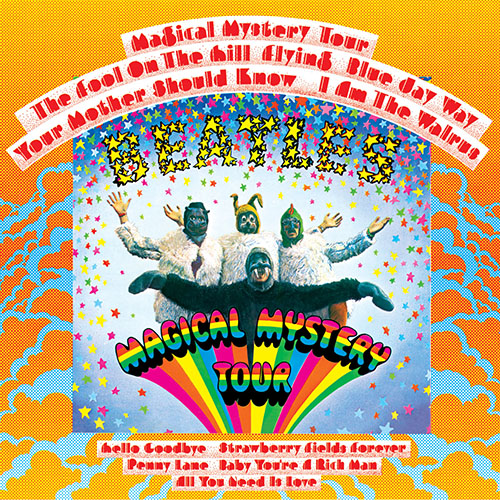
Side One
- Magical Mystery Tour
- The Fool on the Hill
- Flying
- Blue Jay Way
- Your Mother Should Know
- I Am the Walrus
Side Two
- Hello, Goodbye
- Strawberry Fields Forever
- Penny Lane
- Baby, You're a Rich Man
- All You Need Is Love
Best Song: I Am the Walrus
Worst Song: Flying
Magical Mystery Tour was originally released in the U.K. as a double EP set, featuring only the six songs from the TV movie of the same name. In the U.S., it was released as a full album, with the soundtrack songs on Side One and various singles on Side Two, rounded out with "All You Need Is Love," a song written specifically to be performed on Our World, the first ever global television live broadcast.
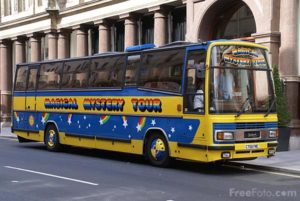
Departing from protocol, the American full-album version has been accepted as canon over the abbreviated British EP set.
This album is a vast improvement over its predecessor. Although the "film side" presents a couple of second tier songs, Side Two is solid. The standout song from the film is "I Am the Walrus," the greatest single song ever recorded. The song was written in response to a letter that John Lennon received from a kid who was attending his old high school. His English master (teacher) had given the class an assignment to analyze the lyrics to Beatles songs. Lennon wrote the song with nonsense lyrics in an attempt to really confuse anyone trying to interpret it. He reportedly told Pete Shotten, his best friend from childhood, "Let the fuckers work that one out."
Paul McCartney continued to display his Music Hall influence with "Your Mother Should Know." This is a much better song than its predecessor, "When I'm Sixty-Four."
George Harrison's sole contribution was "Blue Jay Way," a haunting song that, while decent, is a disappointment after the great songs he had contributed to the prior three albums.
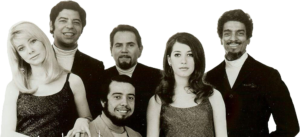
"The Fool on the Hill," written by Paul McCartney, presents an interesting case. The version of the song from the album, while okay, comes off as somewhat bland and uninteresting. The alternate version that shows up on Anthology 2 is far superior. The instrumentation is much better, and its haunting melody is more prominently showcased. This is one of two Beatles songs where I heard a cover version before I heard the one from the band. A year after Magical Mystery Tour was released, Sergio Mendes and Brasil '66 released a Latin version of the song that became one of the best Beatles cover tunes ever. I considered it to be the definitive version of the song before the I heard the Anthology version. (The other song was "I Call Your Name." It was covered by The Mamas and the Papas on their debut album, If You Can Believe Your Eyes and Ears, which was the first rock album I ever bought, which I did when it was released in 1966).
"Strawberry Fields Forever" and "Penny Lane" were recorded during the Sgt. Pepper sessions. In fact, they were the first two songs to be finished. The Beatles intended them for inclusion on the album, but both songs were released as a double A-side on a single and omitted from the album. Written by Lennon and McCartney, respectively, both songs hearkened back to their memories of their childhood in Liverpool. Two more equally great singles, "Hello, Goodbye" and "Baby, You're a Rich Man," round out Side 2 of the album, which ends with "All You Need is Love."
The Sgt. Pepper concept had been so successful that The Beatles decided to revive the concept, this time with themselves replacing the fictional Sgt. Pepper crew as the band. Instead of merely telling the story on the album, this time they decided to make a television movie.
Unlike its two motion picture predecessors, Magical Mystery Tour was a total flop. The music, of course, was brilliant, as was discussed above. However, unlike A Hard Day's Night and Help!, the accompanying film totally sucked. It was so bad that if a first-year student at film school had turned it in as a project, he would have been kicked out. After its dismal performance in England and Australia, they didn't even bother to release it in the United States.
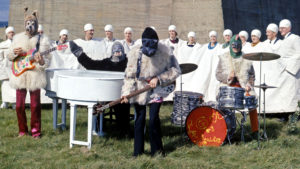
Magical Mystery Tour can reasonably be described as the first "found footage" movie, as the events are filmed as they occur, with no editing. In the movie, which only lasts for an hour, The Beatles gather up a bunch of people to take a tour of the English countryside in a bus. It meanders all over the place, stopping at any place that they might find interesting. In terms of babe appeal, the film is definitely a step down from Help!, as the "Bond Babe" in the earlier movie, portrayed by the beautiful actress Eleanor Bron, is replaced by Ringo Starr's Auntie Jessie, who is anything but.
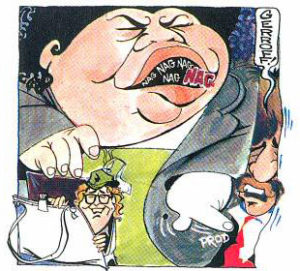
The tour is supposedly being directed by a mysterious group of magicians, who orchestrate everything from afar. Ringo and his aunt continually argue, which annoys all of the other participants (and the audience as well). The only thing that eventually pacifies her is when they stop for lunch, and John Lennon feeds her so much spaghetti that they make her an honorary citizen of Italy. To avoid the spectacle of watching Auntie Jessie stuff herself, everyone else toddles off to watch a strip show.
The film climaxes with a road race, in which each of the passengers on the tour uses a different form of transportation. Ringo Starr manages to win by driving the Magical Mystery Tour bus.
Magical Mystery Tour marks the end of The Beatles' most creative and interesting period, with regard to their music. It also marks the end of the second phase of their career, and almost the last music they would make together before they began to squabble over their personal differences and fall apart as a band.
The Beatles (aka The White Album)
Side One
- Back in the U.S.S.R.
- Dear Prudence
- Glass Onion
- Ob-La-Di, Ob-La-Da
- Wild Honey Pie
- The Continuing Story of Bungalow Bill
- While My Guitar Gently Weeps
- Happiness Is a Warm Gun
Side Two
- Martha My Dear
- I'm So Tired
- Blackbird
- Piggies
- Rocky Raccoon
- Don't Pass Me By
- Why Don't We Do It In the Road?
- I Will
- Julia
Side Three
- Birthday
- Yer Blues
- Mother Nature's Son
- Everybody's Got Something To Hide Except Me and My Monkey
- Sexy Sadie
- Helter Skelter
- Long, Long, Long
Side Four
- Revolution 1
- Honey Pie
- Savoy Truffle
- Cry Baby Cry
- Revolution 9
- Good Night
Associated Singles
- Lady Madonna/The Inner Light (March 15, 1968)
- Hey Jude/Revolution (August 26, 1968)
Best Song: Cry Baby Cry
Worst Song: Long, Long, Long
The gap between the release of Magical Mystery Tour and The Beatles was the longest between two Beatles albums, a full year less five days. This release saw The Beatles beginning the third phase of their career, where they abandoned the complex, psychedelic works they had produced during 1966 and 1967, returning to the simpler ones that had marked their first phase. Yet, it was not a reversion to power pop; their new sound has been described as a more mature "art rock." This long gap was also a productive one, as they wrote enough material to create a double album (and then some).
This album marked the beginning of the end for the band as a unit. The sessions that produced the songs were anything but harmonious, as the various Beatles fought and bickered over anything and everything, leading Ringo Starr and their engineer, Geoff Emerick, to walk out at various times during the recording sessions. Only about half the tracks on the album featured all four of them, with the rest being little more than a collection of solo efforts. The presence of John Lennon's girlfriend, Yoko Ono, in the studio while they were working was perhaps the biggest source of friction. Up until then, they had all observed a strict rule that wives and girlfriends were not to be present in the studio while they were working.
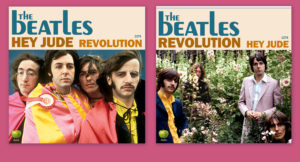
"Hey Jude"/"Revolution" was released during the summer of 1968 as a double A side single. It became the biggest hit of their career, dominating the charts during the summer and fall of that year. It consistently tops almost everybody's list of the top songs of the year, and always places in the top tier of the top songs of all time, usually being outdone only by Led Zeppelin's iconic "Stairway to Heaven."
The double album, rather than being a unified whole like their recent releases, was merely a collection of songs of varying quality, like their early albums. The songs ranged in quality from stunningly brilliant, all the way down to absolute crap. The Beatles starts out strong, with three great songs back-to-back. "Back in the U.S.S.R., written by Paul McCartney, is a parody of the Chuck Berry song "Back in the U.S.A." The background vocals also give it the flavor of a Beach Boys song. It became a huge underground hit throughout the Soviet Union.
"Dear Prudence" was written by John Lennon during The Beatles' trip to India in an attempt to coax Mia Farrow's sister, Prudence, out of her shell. He also wrote the next song, "Glass Onion," in response to Beatles fans who continually claimed to find hidden messages in their songs. It openly references their previous songs "I Am the Walrus" and "The Fool on the Hill."
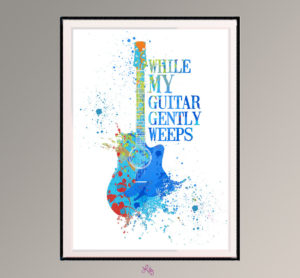
"Ob-La-Di, Ob-La-Da", written by McCartney, demonstrates that there was trouble in paradise, both as to the inconsistency of the quality of the songs on the album and to The Beatles being able to continue working together. John Lennon absolutely hated the song, referring to it as "granny music shit." According to Geoff Emerick, he stormed out of the studio after hearing a demonstration of the song. A little while later, he returned and provided the piano intro. Another engineer who worked at Abbey Road pinpointed the session during which the song was recorded as a key indication that the band was going to break up.
"Wild Honey Pie" was a brief snippet of song featuring terrible vocals and pretty decent guitar playing. It was only included on the album because George Harrison's wife, Patti, liked it so much.
I have a theory concerning "The Continuing Story of Bungalow Bill," written by Lennon, and "Rocky Raccoon," by McCartney. It could be possible that they challenged each other to see who could write the most putrid pile of excrement to be included on the album. I would say that it was a toss-up, with both efforts inhabiting the lowest reaches of Beatledom.

Other standout tracks contributed by Lennon include "Happiness Is a Warm Gun," Sexy Sadie," "Revolution 1," and "Cry Baby Cry." "Revolution 1" is a slower, power ballad version of "Revolution," which had previously been released on the single with "Hey Jude." "Cry Baby Cry" is a particularly great song, with a haunting melody and a mysterious coda added to the end by McCartney.
Paul McCartney weighed in with several great songs of his own: "Why Don't We Do It In the Road," "I Will," "Mother Nature's Son," and "Helter Skelter." He also contributed another Music Hall number, "Honey Pie." While not one of his better songs, it was fairly decent.
George Harrison came up with four numbers for the album, two of which are absolute classics. "While My Guitar Gently Weeps," featuring his friend Eric Clapton on lead guitar, is one of his best. "Savoy Truffle," his other classic, also had a Clapton connection - the song is about a type of chocolate that he particularly enjoyed. "Piggies" is an okay song, while "Long, Long, Long" totally sucks, sucks, sucks.
Ringo Starr came up with one of the two songs during The Beatles' career that he wrote by himself. "Don't Pass Me By" is an enjoyable ditty that, while not a top tier song, pointed toward better things to come when he became a solo artist after they broke up.
"Revolution 9" is the strangest track ever to take up space on a Beatles album. It cannot even be called a song. It is nothing more than an avant-garde collage of spoken word, sound snippets, and unrelated bits of music all jumbled together by John Lennon, George Harrison, and Yoko Ono. Paul McCartney tried to keep it off the album, but Lennon insisted that it be included. Jann Wenner, of Rolling Stone, absolutely loved it. This is no big surprise, considering some of the "artists" that he has seen fit to induct into the Rock and Roll Hall of Shame in Cleveland. Believe it or not, the "song" has been covered by artists like Band of Weeds, Def FX, Little Fyodor, and The Shazam. Phish even managed to perform it live. A classical ensemble called Alarm Will Sound even performed an orchestral version.
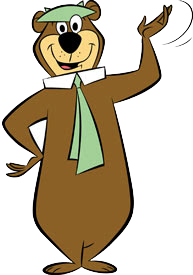
Prior to recording The Beatles, The Beatles retreated to India so that they could commune with the Maharishi Mahesh Yogi Bear. They were joined on this trip by other celebrities, such as Mia Farrow, The Beach Boys, and former vice-president Richard Nixon. Nixon was there to consult the Maharishi for advice on how to attract the youth vote while campaigning for president. The Beatles were there so that they could learn all that there was to know on how to contemplate their navels.
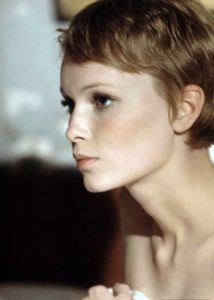
After coming to an understanding of their bellybuttons and how they related to the rest of the universe, The Beatles returned to England. It later came to light that John Lennon had spent more time gazing at Mia Farrow's bellybutton than he had contemplating his own. As for Richard Nixon, the Maharishi advised him to appear on Rowan and Martin's Laugh-In, where he uttered the timeless phrase, "Sock it to me?"
The Beatles' squabbles at the time even extended to arguments over the content of the album's cover. John Lennon wanted the cover to feature a picture of each of them with his wife or girlfriend, all so that he could show off Yoko Ono. Paul McCartney was horrified at the idea - he expressed his preference for a cover showing nothing except for a plate of scrambled eggs. George Harrison pushed for a collage of various pictures of the Maharishi and other spiritual leaders from all over the world. The group seemed to be deadlocked, with none of them willing to give up his idea.
Ringo Starr came up with an idea that broke the logjam. He suggested that the cover just be plain white, and that the title of the album be simply, The Beatles. The others, having grown tired of arguing, quickly agreed to this. Shortly thereafter, the album was released with a white glossy cover that displayed the title in raised lettering that was also white, and a unique serial number stamped upon each copy.
By the time the album hit the record stores, a rumor had begun to circulate that the solid white cover was actually a picture of a pile of white Ku Klux Klan robes. Civil Rights groups were outraged. Negroes refused to buy the album in droves, which led to the establishment of "The White Album" as its nickname. In turn, this sparked a rumor on the other side of the pond that it was actually called the "Shite Album." In any event, riots broke out in several cities across the United States. Once again, Beatles records were being burned - this time by Negroes and other civil rights supporters, as opposed to NASCAR fans from the Old Confederacy. The Reverend Ralph Abernathy, who had assumed leadership of the Southern Christian Leadership Conference after Martin Luther King, Jr.'s assassination earlier that year, called upon The Beatles to call their next album The Black Album.
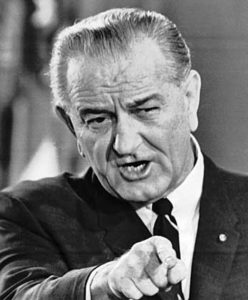
Trying to remain relevant, President Johnson called a press conference to proclaim that Beatles music would be banned at the White House for the remainder of his term in office. Nobody was paying any attention to lame duck Lyndon Johnson by this time, anyway, so his announcement had little effect. President-elect Richard Nixon, who would be assuming the office a few weeks later, urged everyone to remain calm, and called for Johnson to activate the National Guard to restore "law and order."
All of this hubbub over "The White Album" didn't go unnoticed by a certain drifter from the Greater Los Angeles area by the name of Charles Manson. He was the leader of a group of misfits and nutjobs that he referred to as his "family." When he heard the new album, he was electrified. Many of the songs on the album inspired him to put into play an idea that had begun to form in his twisted mind. Listening to these songs and taking their "message" to heart, and following the various riots that had taken place throughout the nation during the 1960s, he came to realize that it was his destiny to start a race war between the white people and Negroes of America. The Beatles were prophets who were divinely inspired to point the way for him to make this idea a reality.
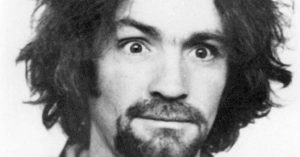
Manson claimed that when he played "Helter Skelter" backward, he could hear John Lennon chanting, "Helter Skelter, pull those triggers; Helter Skelter, kill those niggers; Helter Skelter, show your spite, man; Helter Skelter, off the white man." This, of course, was utter nonsense. Everybody knows that when you play this song backward, what you actually get is, "There's lady who knows, all that glitters is gold, and she's buying a stairway to Heaven; When she gets there she knows, if the stores are all closed, with a word she can get what she came for." In order for him to make the claim about "Helter Skelter" that he did, Charles Manson would have had to be totally insane to begin with; smoke some really great drugs; or try to contemplate his bellybutton without guidance from the Maharishi.
Manson put his plan into motion by arranging for members of his family to commit several gruesome murders of prominent white people. They were to make it look like Negroes had committed these heinous crimes. This would create a white backlash, with white Americans taking vigilante action against Negroes all over the country. In turn, Negroes would respond by killing white people. This would supposedly bring about Armageddon, and Manson would show up to pick up the pieces, with his family proclaiming his arrival on the scene as the Second Coming of Jesus Christ.
Of course, Manson's plan backfired. Fortunately, all of the ado over the cover of The Beatles had died down by the time his murders were committed. In order to stem the tide of rioting in America, The Beatles put out another rumor that the picture on the cover was really that of a white dwarf star. This worked like a charm. After the word got out about the new and improved true nature of the picture on the cover of the album, the Negro community stopped rioting; Negroes began buying copies of The Beatles and found that they really enjoyed it; and Richard Nixon, who by this time had become president of the United States, did not have to call out the National Guard. Accordingly, Manson's claim about the meaning of "Helter Skelter" fell on deaf ears. He was arrested and tried by the State of California. Manson and his family were all found guilty and exiled to the Phantom Zone, where they remain to this day.
The "White Album" was, indeed, "very strange" (as Paul McCartney said in "Penny Lane"). Although seriously flawed by the inclusion of so many second-tier songs, and even some pieces of crap, it remains a worthy addition to The Beatles' catalog.
Yellow Submarine
Side One
- Yellow Submarine
- Only a Northern Song
- All Together Now
- Hey Bulldog
- It's All Too Much
- All You Need Is Love
Side Two
- Pepperland
- Sea of Time
- Sea of Holes
- Sea of Monsters
- March of the Meanies
- Pepperland Laid Waste
- Yellow Submarine in Pepperland
Best Song: Hey Bulldog
Worst Song: All Together Now
Yellow Submarine is the original soundtrack to the animated movie of the same name. Side One features four new Beatles songs, along with the previously-released title song and "All You Need Is Love." Side Two presents an orchestral score written by George Martin. In 1999, this was superseded by the release of the Yellow Submarine Songtrack, which eliminates the orchestral score and includes all of the Beatles songs that were featured in the movie.
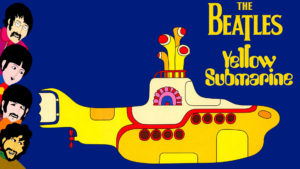
The inclusion of the George Martin score has come under some criticism, with claims being made that, for the first time, a Beatles album doesn't provide value for the money. However, I rather enjoy it. I also think that, after everything he did for The Beatles, Martin was entitled to receive some additional compensation in the form of royalties.
In percentage terms, George Harrison finally received his due. One-third of the songs on the Beatles side were written by him, giving him a portion of the album equal to that of John Lennon and Paul McCartney for the first (and only) time. Ironically, the theme of "Only a Northern Song" centers on Harrison's growing dissatisfaction over his status as a junior partner in Northern Songs, The Beatles' publishing company. "It's All Too Much" could serve as a theme song for the Summer of Love in 1967. The line "...with your long blonde hair and your eyes of blue" was lifted from "Sorrow," a song released by The Merseys in 1966. Both songs were actually written and recorded in 1967, which explains their acid rock nature.
"Hey Bulldog," a great piano-driven song written by Lennon, is the best song on the album. "All Together Now," by McCartney, is okay, but not overly spectacular.
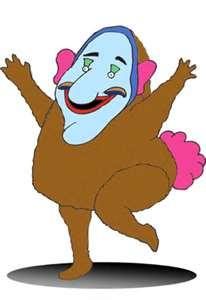
Yellow Submarine was The Beatles' fourth motion picture. Actually, it was a Beatles movie in name only, as they themselves had little to do with it, aside from providing much of the music. It is an animated feature about a mystical place called Pepperland, which is being overrun by the Blue Meanies. "Blue Meanies" is actually a metaphor for Lyndon Johnson and his administration, with Pepperland being the United States. The Blue Meanies absolutely hate music, so they take over all of Pepperland, just so that they can get rid of it.
The Lord Mayor of Pepperland sends Old Fred to sail to Liverpool in the Yellow Submarine to get help. Once there, Fred enlists The Beatles to return with him to help rout the Blue Meanies and liberate the country. Along the way, they sail through many different seas, such as the Sea of Little Green Men, the Sea of Troubles, and the Sea of Potholes. They also encounter many strange creatures as they travel. The film is liberally sprinkled with puns, as well as with great Beatles songs. When they arrive at Pepperland, they defeat the Blue Meanies; magically transform them into Nice People Who Like Music After All; and save Sgt. Pepper's Lonely Hearts Club Band, their Pepperland counterparts, who had been captured.
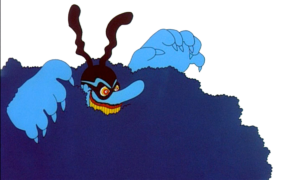
The film is actually quite amusing. While not up to the standard set by The Beatles' first two movies, it is light years ahead of Magical Mystery Tour. The Beatles themselves were not actually in the movie. Of course, their cartoon counterparts were, but their voices were actually done by actors who were imitating them. By the end of 1968, when the movie was being made, The Beatles' partnership was beginning to fall apart, anyway, so it becomes doubtful that they could have worked together on another movie.
Abbey Road
Side One
- Come Together
- Something
- Maxwell's Silver Hammer
- Oh! Darling
- Octopus's Garden
- I Want You (She's So Heavy)
Side Two
- Here Comes the Sun
- Because
- You Never Give Me Your Money
- Sun King
- Mean Mr. Mustard
- Polythene Pam
- She Came In Through the Bathroom Window
- Golden Slumbers
- Carry That Weight
- The End
- Her Majesty
Best Song: You Never Give Me Your Money
Worst Song: Her Majesty
Abbey Road contained many of the final songs written by The Beatles before they broke up and, for the most part, was the last album they recorded. The Get Back sessions, recorded earlier in the year, were shelved and not completed until the following year. Thus, Abbey Road, despite containing more recent songs, leapfrogged ahead of Let It Be to be released several months earlier. In any case, these sessions marked the last time that The Beatles were ever together in a recording studio.
The style of the music was similar to that found on The Beatles, in that it contained their new "art rock," as opposed to their earlier acid rock compositions. While not reaching the heights enjoyed by the best songs on the "White Album," this effort avoided descending to the depths to which that album had sometimes fallen. The best songs on the album, "Come Together," "Something," Because," and "You Never Give Me Your Money," would be considered almost second tier, had they been included on the earlier album. On the other hand, Abbey Road did not contain anything even remotely comparable to such bilge as "Rocky Raccoon," "The Continuing Story of Bungalow Bill," or, especially, "Revolution 9."
Paul McCartney wanted to produce the music on the album as a long medley that encompassed several songs. John Lennon, on the other hand, wanted to do what they had always done - record a series of songs that would appear on the album individually. Lennon got his way on Side One, while McCartney prevailed on almost all of Side Two.
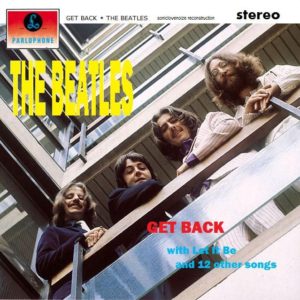
By the middle of 1969, The Beatles were coming to the end of their career as a group. They had been fighting amongst themselves for the past year; the earlier Get Back sessions had fallen apart as a result. When they came together to record Abbey Road, they managed to recapture the old magic one final time.
"Maxwell's Silver Hammer" found Paul McCartney once again dipping into the Music Hall well. While not as good as "Your Mother Should Know" and "Honey Pie," it was better than "When I'm Sixty-Four."
Ringo Starr came through with his second completely self-written number, "Octopus's Garden," which was another children's song like "Yellow Submarine."
George Harrison came up big with two great compositions, "Something" and "Here Comes the Sun." Frank Sinatra characterized the former as "the greatest love song of the last fifty years," and covered it for one of his albums. When Sinatra performed the song live in concert, he sometimes mistakenly characterized it as a Lennon-McCartney composition.
John Lennon was inspired to write the beautiful hymn "Because" when he heard Yoko Ono playing Beethoven's "Moonlight Sonata" on the piano. He asked her to play it backward. She did so, and a new Beatles song was born.
"The End" was appropriately named, as it comprises not only the final portion of the medley on Side Two, but also the last song on the last album The Beatles recorded (if you don't count the short ditty "Her Majesty," which should have been jettisoned from the finished album). It features the only drum solo performed by Ringo Starr to appear on a Beatles album. It also contains a rousing three-way guitar solo recorded live in the studio, with John Lennon, Paul McCartney, and George Harrison trading guitar licks. The last line in the song contains words of wisdom, indeed: "And in the end, the love you take is equal to the love you make." If only they had heeded those words...
Abbey Road provides a fitting coda to the seven-year recording career of the greatest musical act to ever walk the Earth. Although not their best album, it stands half a century later as an incredible musical statement, and a testament as to what can be produced when talented individuals put their squabbles aside and come together to create something magical.
Let It Be
Side One
- Two of Us
- Dig a Pony
- Across the Universe
- I Me Mine
- Dig It
- Let It Be
- Maggie Mae
Side Two
- I've Got a Feeling
- One After 909
- The Long and Winding Road
- For You Blue
- Get Back
Associated Singles and Related Song
- Get Back [Single Version]/Don't Let Me Down (April 11, 1969)
- The Ballad of John and Yoko/Old Brown Shoe (May 30, 1969)
- Across the Universe (from the compilation album No One's Gonna Change Our World) (December 12, 1969)
- Let It Be [Single Version]/You Know My Name (Look Up the Number) (March 20, 1970)
Let It Be...Naked
Track Listing
- Get Back
- Dig a Pony
- For You Blue
- The Long and Winding Road
- Two of Us
- I've Got a Feeling
- One After 909
- Don't Let Me Down
- I Me Mine
- Across the Universe
- Let It Be
Best Song: Across the Universe
Worst Song: Maggie Mae
And so, in the end, the band breaks up. Let It Be, even though it was substantially recorded prior to Abbey Road, stands as the last album to be completed by The Beatles (not including the Anthology series from the 1990s.) As previous mentioned, the tracks were laid down early in 1969 by a band that was in its death throes. The idea was to "get back to where they once belonged" by moving to a different venue and performing the tracks live, so that they would be suitable for public performance in potential future shows. Unfortunately, the bickering got to be too much, and they abandoned the project. Soon thereafter, they reconvened in their new Apple recording studio and went to work on Abbey Road. The tapes were shelved and, for a time, abandoned.
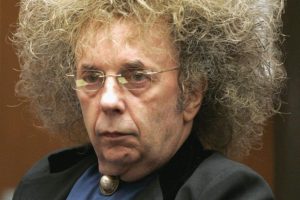
A year later, producer Phil Spector was brought in to resurrect the tapes and produce an album. He remixed all of the tracks, adding strings and choir to some of the songs. The result, which was given the new name Let It Be, was released two months later. Paul McCartney, in particular, was unhappy with the result, especially Spector's treatment of his song "The Long and Winding Road." John Lennon, on the other hand, praised it. He stated, "He [Spector] was given the shittiest load of badly-recorded shit with a lousy feeling to it ever, and he made something of it." George Martin, who had produced the original recordings, was denied production credit for the finished album. He responded by saying, "I produced the original, and what you should do is have a credit saying 'Produced by George Martin, over-produced by Phil Spector.'"
Fast-forward about 33 1/3 years, and we find Paul McCartney completely re-producing the album. He re-sequenced the tracks, chose different versions for some of them, removed the two short ditties, "Maggie Mae" and "Dig It," added a new version of "Don't Let Me Down," and removed the dialog that could be heard between some of the tracks on the original album. Most importantly, he completely removed all of Phil Spector's "improvements." The resulting album, Let It Be...Naked, was astounding. The songs are much clearer and crisper, some of the versions are better, and they sound much closer to what The Beatles had originally intended them to sound like.
Most of the songs on the album (including the singles) were at least decent, with some being great. Highlights include "Dig a Pony," "Across the Universe" (Our World and Naked versions), "Let It Be" (Single and Naked versions), "Get Back" (Single and Naked), "The Long and Winding Road (Naked), "I've Got a Feeling," and "The Ballad of John and Yoko." McCartney was wise to omit "Maggie Mae" and "Dig It" from Naked, although adding "Don't Let Me Down" was a big mistake; Lennon's whiny vocals in that song drive me nuts. The version of the title song chosen for the album by Spector is the worst one that he could have picked. The loud guitar solo in the middle is totally out of place in such a beautiful song.
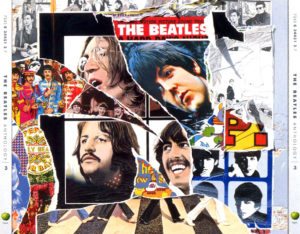
So now we come to the end of The Beatles as a group. Each went on to enjoy a productive solo career, producing a lot of great music during the 1970s and beyond. The four of them would never again make music together, although each one did guest star on Ringo Starr's Ringo album in 1973. In 1994, the three surviving Beatles (John Lennon had been assassinated in 1980) got together to create the Anthology project. They went through all of their old recordings and culled enough tracks to create three 2-CD (3-LP) sets. The project included live performances, in-studio performances broadcast on the BBC, alternate versions of songs that they had included on their albums and singles, and even songs that had been completely unreleased. To top it off, they created two brand new Beatles songs by taking two unfinished John Lennon tracks and finishing them up. "Free as a Bird," a 1977 demo recording, was enhanced by the surviving Beatles and released as a single, and as the first track on Anthology 1, which was released in 1995. This was the first new Beatles song to hit the charts in twenty-five years. "Real Love," released on Anthology 2 the following year, was taken from a recording made by Lennon in 1979-80. "Free as a Bird" comes off as a pretty decent song, especially for a band that had been apart for a quarter of a century. "Real Love" was fair to middling at best.
And in the end, the love you take is equal to the love you make.

